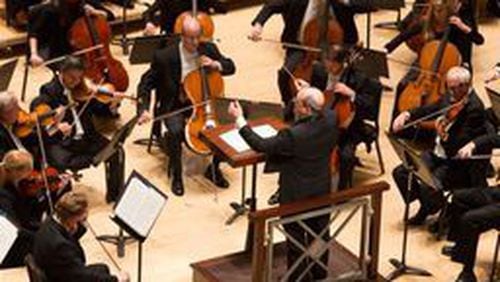Two years after rancorous contract negotiations, a lockout and a narrowly averted postponement of the Atlanta Symphony Orchestra’s season, ASO management and its musicians face a Sept. 6 deadline to strike a new collective bargaining agreement.
Both sides are holding their cards close, saying they don’t want to negotiate in public, in hopes of forging a new deal that would allow the 70th anniversary season to open as scheduled on Sept. 25. But there are clear indications that management is seeking further concessions from the players, who claimed when the two-year agreement was announced in September 2012 that the cuts they reluctantly conceded to would set the orchestra back for years.
The ASO finished the 2014 fiscal year with a $2 million operating deficit, the figure management had projected, on a budget of $37 million. It was an improvement on fiscal 2013’s $2.9 million deficit and 2012’s $5 million deficit.
“That definitely is progress, but it still is not sustainable,” ASO spokesman Randy Donaldson said. “You’ve lost another $2 million in the last year and … that’s after more than a decade of deficit operations.” The ASO has finished every fiscal year in the red since 2003.
Daniel Laufer, an ASO cellist and a member of the negotiating committee for the musicians’ union, declined to specify issues on the table after a year of talks, choosing his words carefully. “The musicians want to reach a contract with management that does not repeat the situation from two years ago,” he said.
That deal cost the ASO Players Association $5.2 million over the two years. The ASO reduced the number of full-time musicians from 95 to 88, and trimmed the salaried season from 52 to 41 weeks in 2012-13 and 42 weeks in 2013-14.
That last concession was a bitter one for the musicians. Beyond the individual sacrifice was the symbolic: A full year of salary is considered a signpost of the country’s best orchestras. ASO Players Association leaders expressed concern at the time that the orchestra would have trouble retaining its best musicians and recruiting top new ones.
Though player movement is a fact of orchestral life, there have been notable retirements and departures of late. The latter include principal trombonist Colin Williams and horn player Richard Deane, both starting at the New York Philharmonic this fall, and cellist Jennifer Humphreys, who is joining the Dallas Symphony Orchestra.
“The musicians are not, and have never been, the cause of financial problems at the ASO,” union leaders asserted in a statement at the time of the 2012 agreement. “Management must be held accountable for under-performance at nearly every level for the past decade.”
Musician salaries account for nearly a quarter of the ASO’s budget, underlining the pressure as the contract deadline approaches.
The orchestra’s financial picture has changed somewhat since the 2012 accord.
The ASO’s accumulated debut rose to $23 million by the end of the 2012 fiscal year, including $18 million borrowed against earnings on its endowment and $5 million owed to its parent nonprofit, the Woodruff Arts Center.
In May, the ASO and Woodruff’s boards, trying to ease the financial pressure and making the obvious assumption that surpluses that would fund a gradual pay down are not on the immediate horizon, decided to treat that loan as a distribution. That means the loan does not have to be paid back. Thus the orchestra’s accumulated debt is now down to the $5 million owed the Woodruff.
The ASO’s endowment, valued at $98.5 million in 2007, is now worth $70 million, with Romanstein having decreed two years ago that the orchestra could not continue that borrowing practice.
While declining to delve into specifics of the ASO negotiations, Woodruff President and CEO Virginia Hepner spoke generally. “The most important priority, as it is with all of our art partners here, is to together create a sustainable operating model,” she said. “Deficits are just unsustainable. It doesn’t matter if it’s a small organization or a big organization, we can’t afford to continue that.”
While the musicians’ salary cut has by far been the biggest contributor in the ASO’s improving financial performance, the administration cites other factors, too.
The ASO carried a full-time administrative staff of 61 two years ago. The number has been reduced to 47 through attrition and some employees being moved to the Woodruff’s payroll, Donaldson said. Also, ASO Presents, the department responsible for the orchestra’s series at Chastain and Verizon Wireless amphitheatres, has increased revenue by booking more non-ASO shows in Symphony Hall, from a half-dozen two years ago to 30 this year. Upcoming ASO Presents concerts include Jethro Tull, Erasure, Rufus Wainwright and Susan Boyle.
Donaldson predicted that negotiations would continue even if a new collective bargaining agreement is not reached by Sept. 6.
“But at some point,” he said, “the ASO would have to cancel concerts in deference to patrons and their schedules.”






